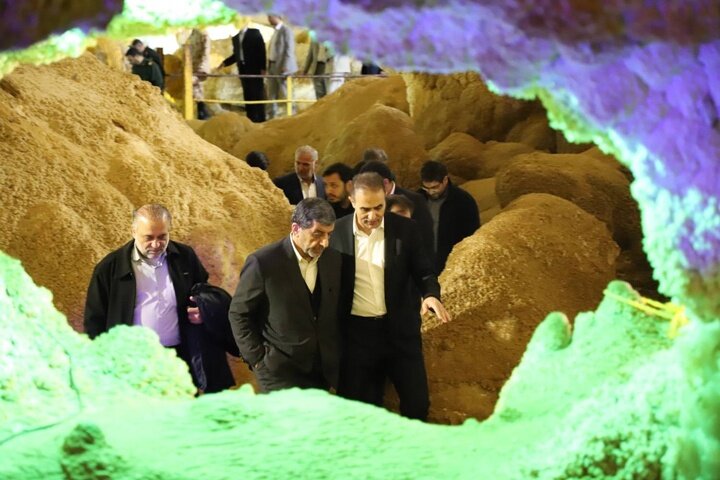Minister lauds ‘surprising’ cave appeals, suggests recommendations in personal visit

TEHRAN – On Friday, Iranian tourism minister Ezzatollah Zarghami paid a visit to Katale-Khor Cave, whose main entrance is located some 150km south of Zanjan, off the Soltaniyeh–Hamadan road near Garmab, in western Iran.
Stepping inside, the minister lauded the natural splendors of the massive cave and suggested recommendations concerning tourism amenities and development work.
“Attractions in Katale-Khor Cave are incredible, surprising and wonderful,” Zarghami said.
Katale-Khor (that literary means “Mountain of Sun”) is estimated to date from tens of million years ago. It features millions of lime stalactites and stalagmites. The cave interiors embrace huge hallways and corridors, which are impressively lit by flashlights.
Calling for completion of lighting system, he said “The [existing] lighting highlights only part of the beauty of this cave, which if completed will definitely attract more tourists to the cave,” he said.
Talking about a road that leads to the cave, the minister said: “I suggest adding other charms, to attract the audience along the way.”
Elsewhere in his remarks, Zarghami emphasized the need for preparation of a comprehensive development plan while making proposals for developing sanitary and accommodation services and widening the road that leads to the cave.
Moreover, he said preliminary stages of work should be carried out for possible registration of the cave on UNESCO list of World Heritage.
“We must introduce this cave collection to the people of the world, whose tourism is their right,” the minister concluded.
According to available data, some three-sevenths of the prolonged cave have been explored so far. A length of about 3km of the cave is open to the public, while a 4km-route is accessible to experienced cavers and researchers.
Having a wealth of geological and cultural treasures, caves have always been mysterious and fascinating for adventurers. Cave tourism is a unique and rewarding form of traveling that allows visitors to discover the hidden wonders of the earth, contribute to the local economy, and support conservation and scientific research.
Iran is geologically part of the Alps-Himalayan natural belt. According to the Britannica Encyclopedia, there is puzzling evidence of human presence on the Iranian Plateau as early as the Lower Paleolithic. The first well-documented evidence of human habitation comes from deposits from several excavated caves and rock shelters located mainly in the Zagros mountains of western Iran, dated to the Middle Paleolithic or Mousterian period (c. 100,000 BC).
AFM
Leave a Comment